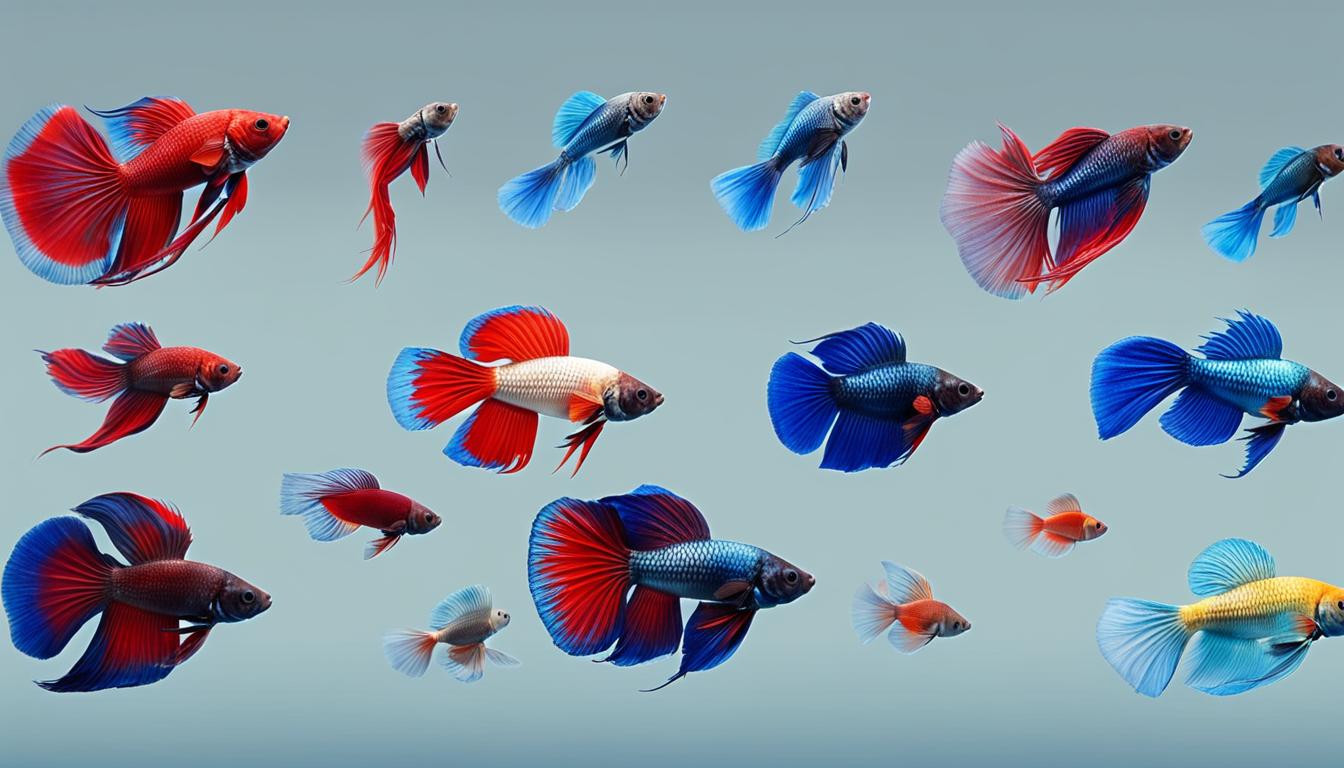Betta fish, also known as Siamese fighting fish, are bright and colorful species popular in home aquariums. If you’re considering getting a betta fish as a pet, you may be wondering about their size and how big they can actually get. In this article, we will explore the average size of betta fish, factors that influence their growth, and the importance of tank size for their overall well-being.
Key Takeaways:
- Betta fish typically reach a maximum size of around 3 inches or 7 cm in length.
- The average size of betta fish is approximately 2.25 inches or 5.7 cm in length.
- Factors like temperature, feeding process, genetics, sunlight exposure, and diet can impact the growth of betta fish.
- Tank size plays a significant role in the growth of betta fish, with larger tanks allowing for better growth and more swimming space.
- Providing a suitable habitat with clean water, proper filtration, and a varied diet is crucial for the optimal growth and health of betta fish.
Factors That Influence Betta Fish Size
Several factors can influence the size of betta fish. Let’s explore some of the main ones:
Temperature
The temperature of the water is crucial for the growth and well-being of bettas. These beautiful fish require specific temperature conditions to thrive and reach their full size. If the temperature is not suitable, they may experience stunted growth. It is important to maintain the water temperature within the recommended range to ensure optimal growth.
Feeding Process
The feeding process also plays a significant role in the growth of betta fish. Bettas need a balanced and nutritious diet to support their growth. Providing them with high-quality food that contains the essential nutrients they need will help them reach their maximum size. It is important to follow a regular feeding schedule and avoid overfeeding, as it can lead to health issues.
Genetics
Genetics can also influence the size of betta fish. Some genetic traits can lead to larger or smaller individuals. Breeders often take the size of the parents into consideration when breeding bettas to achieve desired sizes and characteristics. However, it is important to note that genetics alone do not determine the size of bettas, as other environmental factors also play a role.
Sunlight Exposure
Sunlight exposure can impact the growth of betta fish. Bettas in tanks with more sunlight exposure may potentially grow larger compared to those in darker environments. Natural sunlight provides important vitamins and promotes healthy growth. However, it is crucial to strike a balance and ensure that the tank does not receive excessive direct sunlight, as it can result in algae growth and temperature fluctuations.
Diet
The type of food that bettas eat can greatly affect their growth. A diet rich in protein and essential nutrients promotes faster and bigger growth. High-quality betta pellets, live or frozen insects, and occasional treats like bloodworms or brine shrimp can contribute to healthy growth. It is important to provide a varied diet to meet their nutritional needs and support optimal growth.
By considering these factors and providing optimal conditions, you can ensure healthy growth and promote the full potential size of your betta fish.
The Importance of Tank Size for Betta Fish Growth
Tank size is a critical factor when it comes to the growth of your betta fish. While they can grow in smaller tanks, giving them more swimming space in larger tanks can support better growth. In smaller tanks, bettas tend to stop growing at around 1.5 to 2 inches, regardless of how well they’re fed. On the other hand, bettas housed in larger tanks are known to grow bigger, with larger fins.
However, it’s important to note that the size difference between a small and large tank is typically minimal, only around 0.1 to 0.25 inches. The primary advantage of a larger tank is the ability to accommodate more types of fish, rather than significantly impacting the size of your betta fish.
When setting up a habitat for your betta fish, it’s crucial to consider the tank size and aim for one that provides adequate space for swimming and growth. Providing a clean and healthy tank with proper filtration, good water quality, and a varied diet will also contribute to the growth and overall well-being of your beloved betta fish.
FAQ
How big do betta fish actually get?
Betta fish can reach a maximum size of around 3 inches or 7 cm in length, but the average size is approximately 2.25 inches or 5.7 cm.
What factors influence the size of betta fish?
Several factors can influence betta fish size, including temperature, feeding process, genetics, sunlight exposure, and diet.
How does tank size impact betta fish growth?
While bettas can grow in smaller tanks, larger tank sizes provide more swimming space and can support better growth.
